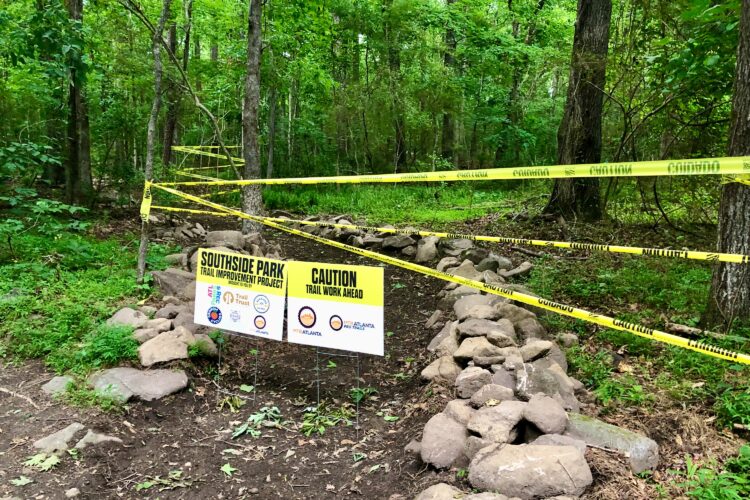
Mark Jenkins thinks he’s onto something. The former Tesla Engineer in charge of helping write the company’s self-driving vehicle software, Jenkins became frustrated with the government red tape involved in designing an autonomous system that has to account for hundreds of traffic laws and safety regulations. Instead, he realized building a self-navigating mountain bike could be accomplished on a much shorter timeline and with fewer regulatory hurdles. The aMTB (autonomous mountain bike) is his early attempt at realizing his vision for a self-driving future.
The Idea
Jenkins is an avid mountain biker and, as the treasurer of his local Bay-area mountain bike club, he learned the club had a problem with riders poaching illegal trails. After reading about how drone makers had pre-programmed no-flight zones into the devices they were selling, Jenkins realized the same could be done for mountain bikes. But first, the mountain bike would need an auto-pilot function similar to the one utilized by those drones.
Jenkins knew the GPS chips and cameras for building an autonomous navigation system would be easy to find, especially with the recent explosion of the drone market. In his spare time, Jenkins threw together a rough prototype using an old Specialized Rockhopper hardtail fitted with servo motors to control the steering and brakes, and a gas-powered bicycle conversion kit (he plans to utilize a fully electric Bosch drivetrain in the production model). The steering and brake servos, throttle, and drone sensors were then wired into an inexpensive Arduino control board running Linux.
Early Tests
After a couple months of work, Jenkins had a functional prototype programmed to ride in a simple figure-8 pattern, which he tested at a moto-legal trail in the south Santa Clara Valley. Several mountain bike buddies joined him on his test runs, and after seeing their reactions, along with those of curious dirt bikers, Jenkins knew he had a winning idea. There was only one problem: everyone who tried riding the early aMTB crashed hard, including Jenkins himself.
It turns out that balancing a self-steering, auto-navigating mountain bike is easier said than done. If you watched Phil and Seth’s recent tandem mountain bike video, you know that separating steering from balancing has a weird effect on bike handling, to say the least. Jenkins spent weeks working on a warning system with LED lights to indicate to the rider when the system was about to steer left or right, so the rider could get into position. Give too much warning and the rider would shift his weight too soon; give too little and the rider wouldn’t have a chance to react in time.
After yet another frustrating test ride, Jenkins remembered Ginger. That was the code name of Dean Kamen’s Segway project, which the inventor boasted would change the face of transportation around the world. Of course the Segway never took off commercially, but it had introduced the idea of a self-balancing system built around a cluster of gyroscopes and tuned-mass dampers. Could a computer-controlled, gyroscopic balancing system be the answer to the aMTB’s problem?
Rather than trying to invent a self-balancing system on his own, Jenkins bought a used Segway off eBay and took the thing apart. It turned out fitting the gyroscopic balancers to a mountain bike was a piece of cake, especially compared to trying to balance a scooter with side-by-side wheels. With this addition, the autonomous Rockhopper truly came to life. And as a nice side effect, the bike wouldn’t need a kickstand–it could balance itself on two wheels! Jenkins was finally ready to quit his job at Tesla.
Validation
Now that the aMTB could steer, propel, and balance itself, it was time for Jenkins to put his programming skills to work. Having worked on creating some of the algorithms that give Tesla vehicles their ability to safely change lanes on the Interstate, Jenkins used computer vision and machine learning to “teach” the system how to identify a trail and to stay on it. This proved more difficult than he initially imagined. Singletrack trails are fairly straightforward, but places like Slickrock in Moab gave the system fits. Not only that, the computer was confused by transitions where trails led into parking lots or across roadways.
Thinking back to his original motivation–to create a mountain bike that would enforce responsible riding–Jenkins realized that if he could program the places a bike shouldn’t ride, he could also program in the places a bike should ride. Jenkins loaded up the onboard computer with GPX data for several local trails pilfered from Strava, and set out to see if the bike could navigate the track on its own, without the use of computer vision.
As a local bike club officer, Jenkins knew it wasn’t exactly legal for him to ride a gas-powered mountain bike at Skeggs (though curiously, eMTBs are legal on many trails not open to gas-powered motorized vehicles in California). Luckily, the state is friendly to tech projects like this, so Jenkins was able to get a one-day, special-use permit to ride his contraption at El Corte de Madera Creek Open Space. He would have one shot to prove that his navigation system could work on a real mountain bike trail.
Jenkins showed up with his friends at the trailhead just before dusk. Unloading the steampunk-looking contraption, he got a few weird looks, but not as many as he thought he might–this was the Bay Area after all. After a few adjustments and a crank of the gas-powered engine, Jenkins was ready to begin his test. The loud, 2-stroke engine was deafening, its noxious exhaust sickening, but Jenkins knew these issues could be resolved. What really mattered was whether the bike would be able to steer, balance, and navigate as well as or better than a rider could on his own.
The smartphone mounted to the handlebars showed a list of possible Skeggs routes to choose from, and Jenkins selected one called, “Lunch Ride.” Next, the custom app prompted him for a speed selection: chill, relaxed, tempo, or gonzo. Since this was his first test, Jenkins selected “chill” and chose “beginner” for line selection (other line choices would later include intermediate, advanced, and expert). A countdown on the screen began at 5, giving Jenkins time to clip into the pedals and get into position. Then, the bike started off down the trail on its own, with Jenkins’ friends cheering and following closely behind on their classic mountain bikes, half a dozen GoPros capturing the whole scene.
The Future
It’s been a few weeks since that initial test run and Jenkins continues to tweak the system based on his 5-mile test. He’s also working on his marketing plan for the world’s first aMTB, which he plans to launch on Kickstarter in early 2018. A few friends and family members recently pitched in seed funding so Jenkins can build a second prototype with an electric drivetrain.
Beyond just keeping riders on approved trails, Jenkins plans to market the safety aspects of aMTBs, which he claims are crash-proof thanks to the automatic braking system and gyroscopic balance. And for riders who can’t keep up with friends who are faster, more competent mountain bikers, aMTBs open up more technical trail rides that were not accessible before.
Jenkins also hopes to program in an “air” mode that will assist in landing jumps on the aMTB. Currently the bike is limited to short hucks, but air mode will allow the bike to adjust its attitude in mid-air for a perfect landing every time. While it’s unlikely anyone will be riding Rampage lines on an aMTB anytime soon, boosting bike park jumps and gaps should be no problem.
Mountain bike advocacy organizations are excited about the prospects for the aMTB thanks to its ability to prevent illegal trail riding, and they’re pushing Jenkins to add speed regulators and “wet trail avoidance technology” as well. Jenkins says the technology to do all these things and more is already available, it’s just a matter of someone putting all the pieces together.
“I truly believe the aMTB will make mountain biking better for everyone, so I’m focused on making this technology as affordable and accessible as possible.”
Thanks for reading the whole article! The primary purpose of this article is not to deceive, but rather to explore what mountain bikes might become in the future as we continue to add electronics and powered drivetrains to our rigs. As far as we know, there is no one developing an autonomous mountain bike at the moment. But that’s certainly not to say it couldn’t happen in the future, so it’s important to consider the impact such a development might have on our sport.











2 Comments
Apr 3, 2017
Apr 1, 2017